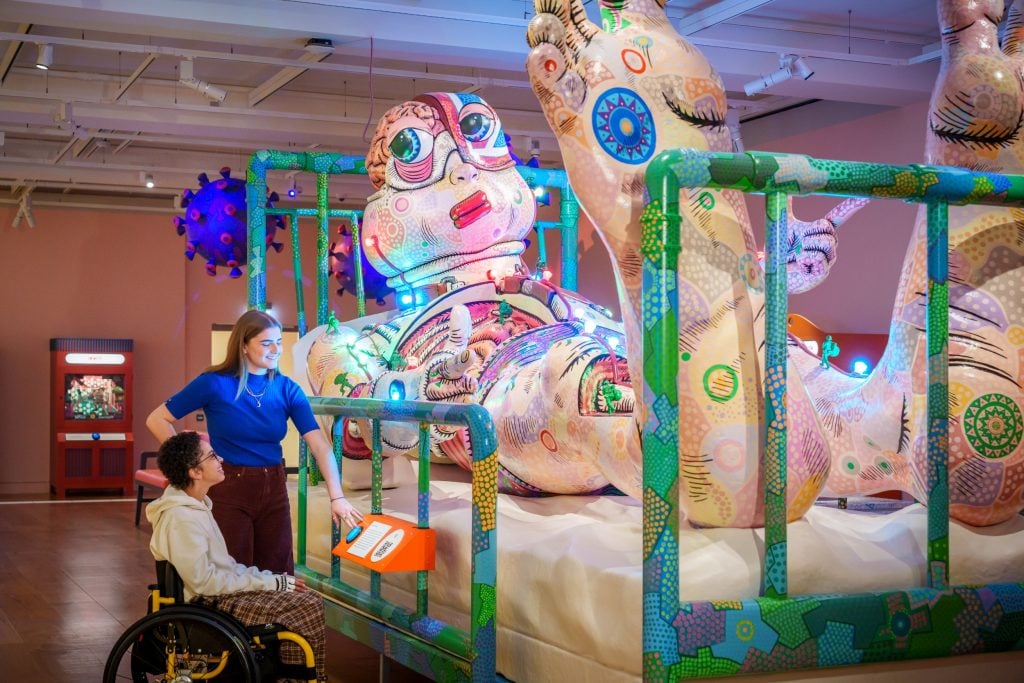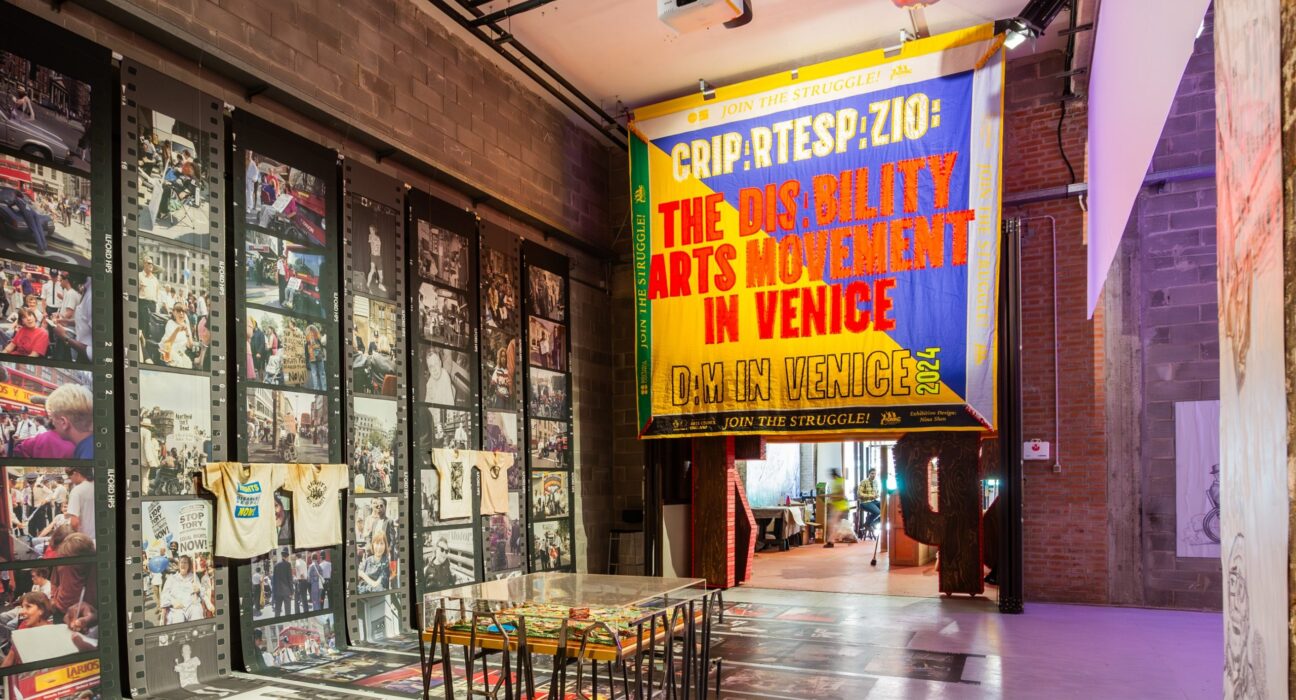“The art I create is a celebration of life,” said Jason Wilsher-Mills, who was diagnosed as a young boy with an autoimmune condition that eventually led to paralysis from the neck down. “It’s not maudlin, it’s created with humor.”
The British artist is part of a growing number of creatives who identify as disabled and have chosen to make work addressing their experience. Whereas historically disability was socially seen as something to be overcome, several recent exhibitions show how artists have flourished in step with the battle for disability rights, providing visibility for experiences that were long misunderstood or marginalized.
Wilsher-Mills currently has work in “Crip Arte Spazio” at CREA on Venice’s Giudecca Island, which maps out the history of the disability arts movement. He is also the subject of a solo show at the Wellcome Collection in London, through January 12, 2025. For this, he has created a lively, immersive ode to life in a hospital bed through the eyes of a child, who takes the form of a kaleidoscopic kitsch, larger-than-life statue within the exhibition. Various timelines merge along the walls so that we can see, for example, which song was number one on the day he received a lumbar puncture, underscoring how Wilsher-Mills’s life was forever changed but the world around him carried on as before.

Installation view of “Jason and the Adventure of 254” by Jason Wilsher-Mills at the Wellcome Collection in 2024. Photo: Benjamin Gilbert.
Looking back, Wilsher-Mills sees his diagnosis as emancipatory, in some sense.
“In 1980, the best expectation for a working-class lad from a family with no money was working in a factory,” he said. “When I became disabled, it was the birth of my creativity. I was living in my head. I couldn’t move so all I could do was draw. That year, I forged the artist that I would become.”
Yet, for some artists, the decision to center experiences of disability in their practice is a sensitive one. “I didn’t want my work to just be viewed through that lens of disability,” said Jo Longhurst, who had previously used her practice as “an escape from the day to day difficulties of chronic illness.” She decided to initiate the long-term project Crip after frequent encounters with bindweed during walks around her neighborhood in London during lockdown.
“It’s a much maligned weed but it’s also a native plant and it provides an ecosystem for insects and birds,” she explained. Its ability to grow in unfavorable conditions felt like a suitable metaphor for her situation.
An initial moving image piece “Here, Now” from Crip was debuted at Studio Voltaire last summer. The collage of bindweed and 19th century photographs of female patients in asylums is interspersed with portraits of members from a contemporary collective of artists who all live according to “crip time,” the theory that disabled people experience time differently and therefore require certain accommodations.
Installation view of “Here, Now” by Jo Longhurst at Studio Voltaire in 2023. Photo courtesy of the artist.
Longhurst’s decision to feature other artists helped shift the emphasis away from herself to provide a more universal lens on life with an invisible condition.
“There can be a pitfall of falling into some kind of disability ghetto where the only people who will come to see the work are those with a direct stake in the matter,” she said. “I’m sure that everybody at one point in their life feels unseen and they’d like more understanding.”
Most able-bodied people nonetheless live at a remove from medical systems and tend to view healing as a linear process. Disabled artists have shed light on a less sanitized, convenient reality. French artist Benoit Piéron underwent leukemia treatments as a child and recently underwent further cancer treatment as an adult. For his exhibition “Slumber Party” at Chisenhale Gallery in London last fall, sheets were stitched together into a colorful canopy, but they still bear the bodily stains from their previous life lining hospital beds.
“I’ve decided to try and build on what could have destroyed me,” said Piéron of the many childhood years he spent in hospital. “My works are so gentle that they allow us to dare look things in the face that are a bit hard.”
Though Canadian artist Sharona Franklin’s playfully surreal assemblages embalmed in gelatin are immediately eye-catching, they are also packed full of ephemera that record how her personal experience of living with a rare degenerative disease exists within global systems. The multidisciplinary artist, writer, and disability rights advocate is perhaps best known for her botanical jelly sculptures she shares on Instagram as @paid.technologies but her work has recently been featured at Art Basel in 2023 and in several museum shows.
The patches on a recent floor work, Utricle Quilt – Membrane Comforter (2023), included in “Interdependencies: Perspectives on Care and Resilience” at Zurich’s Migros Museum earlier this year, contains both organic materials like kidney beans, foraged animal bone, and oat straw herb as well as IV and catheter tubing, expired pharmaceuticals, and part of a medical knee brace.
“The patches speak to the environmental variability of bioethics, and the transcontinental movement of humans, animals, and goods speaking to geopolitical ethics,” said Franklin, “Symbiosis is important in my work, so I often use biomaterials, plants, and upcycled objects to reflect environmental harm, wellness capitalism, and the interconnection of epigenetics and access to care.”
Franklin had originally hoped to study science but struggled to navigate the educational system so began making art as a hobby.
“I joke that I became an artist simply by exclusion. I could not find a path in any other career,” she said. “I still love to research and absorb scientific information daily as it helps to inform the materiality and educational aspects of my practice.”
Still, the physically intensive nature of many art practices also comes with health risks that are usually overlooked. In order to make a living from art, most artists must be strict about the hours they put in. Disabled artists are increasingly vocal about the practical challenges that alter how and when they work.
For Loribelle Spirovski, painting up to eight hours everyday resulted in a serious repetitive strain injury affecting her dominant hand. She has since had to adapt her approach, reducing the size of her canvases to make her work more manageable, which also reduces prices. Many of these more recent works are abstracted, pared down portraits made principally out just a few gestural lines and only partially embellished with more lifelike detail.
“I simply wasn’t capable of doing more arduous work,” she said.
Spirovski believes she was lucky that, just prior to the injury, she had been picked up by a gallery in her hometown Sydney. It took away the pressure of being an emerging artist. “It’s almost like my brain and body were hanging in there until a certain point, then everything just collapsed,” she said.
While studying at the Royal College of Arts, Longhurst found being in the studio demanding and sometimes had to work in her bedroom instead.
“That constraint resulted in very different kinds of works,” she said. Sometimes, she feels very frustrated at the pace she is able to work or that a concentrated activity can only be done for a short amount of time, but she adds that she breaks projects down into manageable parts that can be put down and picked up again. She has chosen not to expend limited energy on going to openings or networking with galleries.
Loribelle Spirovski, Homme 308 (2023). Image courtesy of HOFA, London.
Franklin usually uses a power wheelchair, converting to a walker on “good days.”
“We live with high expenses, known as the invisible ‘Crip Tax’,” she said, citing a U.S. study that found disabled people must work 28 percent more to achieve the same standard of living as non-disabled people. She mentioned housing insecurity and care needs as daily considerations that “occupy so much of my finances and tangible time,” as well as having to use limited space in her home as a studio.
“I have to block off certain weeks a year from medical appointments to be able to make art,” she added. “My physical capacity is very limited by debilitating pain and fatigue.”
“I do things that make me feel good,” said Piéron.” I sew while listening to drone music. I don’t do ceramics anymore and I don’t do anything heroic or muscular. I just slide from my bed to the sewing machine.”
The social model of disability, which has become increasingly central to the ongoing fight for disability rights, posits that rather than these barriers being seen as an inevitable part of living with disability, they should be understood as solvable problems inherent to an ableist society.
“[Being an artist] is the only job that I’m designed to do,” said Wilsher-Mills, “but its a struggle.” He mentioned limited infrastructure, besides specialist organizations like Shape Arts and Unlimited, meaning he had to support his practice for over a decade by delivering workshops until this extra work became too exhausting. “There’s a need for better support for disabled people that want to learn how to become professional artists.”
Follow Artnet News on Facebook:

